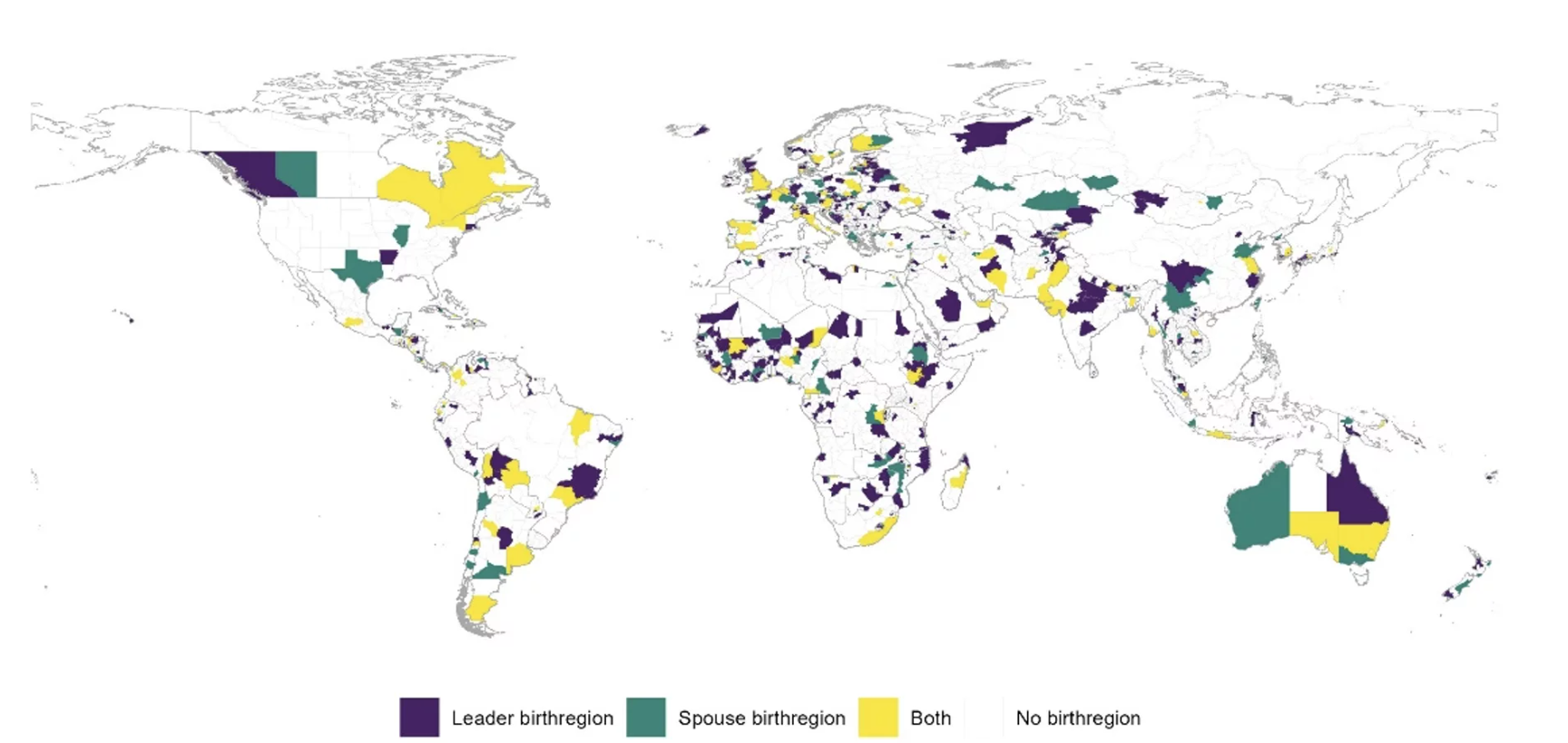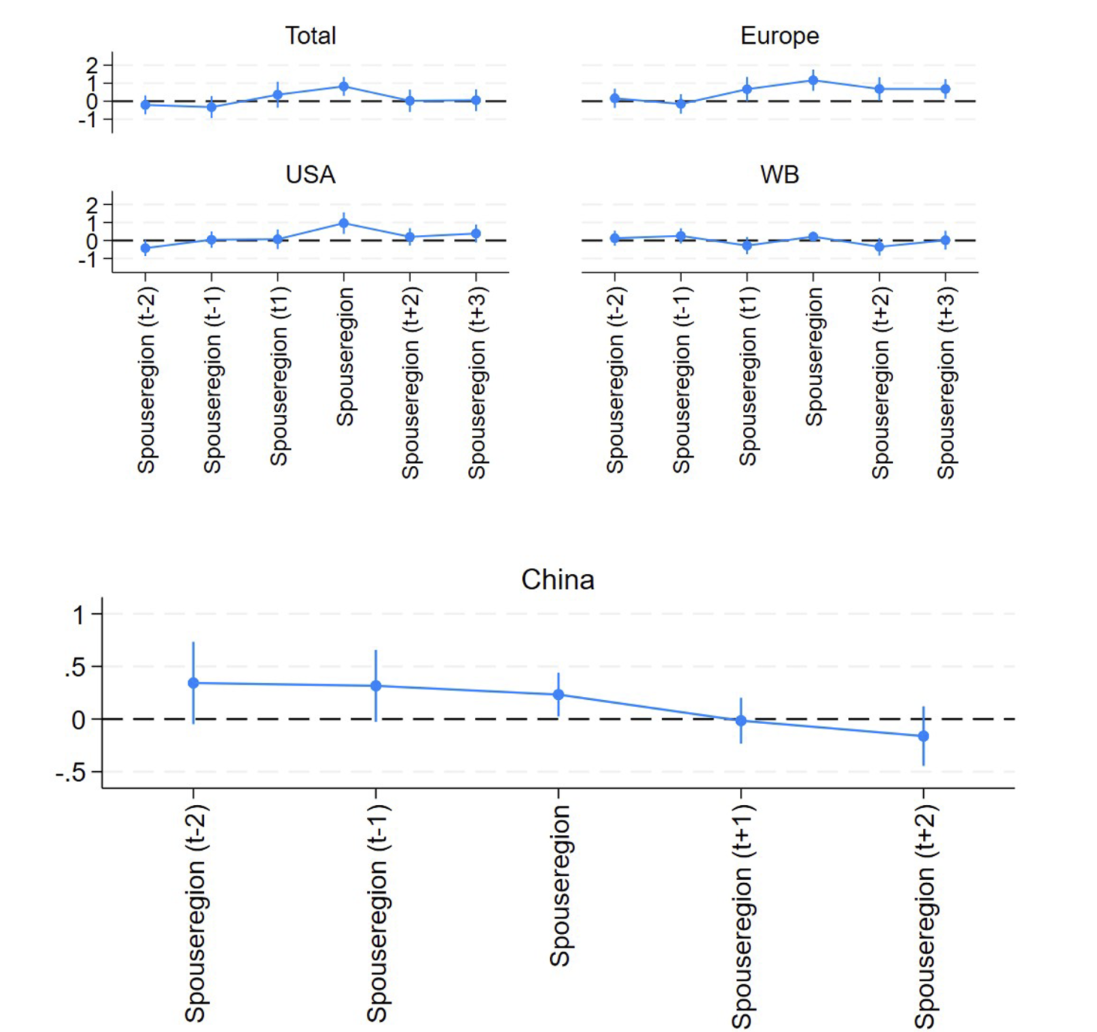
The birthplaces of the spouses of political leaders receive more than three times as much aid during the tenure of their partners than the same sub-national region would receive at other times.
“I hope that someday someone will take the time to evaluate the true role of the wife of a President"
U.S. President Harry S. Truman, cited in Gonnella-Platts and Fritz (2017: 5)
Editor's note: This article originally appeared on VoxEU.
In 1979, when asked about the wealth accumulation among her family’s acquaintances and allies during the tenure of her husband, Imelda Marcos, the wife of the then Philippine president, responded: “Well, some are smarter than others” (Branigin 1984). History abounds with examples of unelected, yet influential, family members leveraging their position for personal gain. As Uruguayan first lady Maria Julia Pou put it, “you are not a simple citizen and nobody looks at you as a simple citizen. When a first lady picks up the phone and calls somebody, it’s Somebody” (cited in Gonnella-Platts and Fritz 2017: 30). Spouses are unelected yet oftentimes important advisors to their partner, exerting influence over their decisions. They derive status from their marriage and sometimes control access to the leader, which may make it difficult to turn down their requests. Arguably, spouses can use such power to affect policies and outcomes.
To what extent familial relations affect policies has been investigated in a number of ways. Studying the voting behaviour of US congressmen, for example, Washington (2008) finds that congressmen with daughters are substantially more likely to vote in line with feminist views. McGuirk et al. (2023) show that congressmen with draft-age sons are less likely to vote for conscription. The influence of elected politicians’ relatives on the allocation of resources or developmental outcomes has also received attention (e.g. O’Connor et al. 1996, Van Wyk et al. 2018), but has been investigated mainly based on qualitative and selective data.
In a new paper (Bomprezzi et al. 2024), we provide quantitative evidence on how political leaders’ spouses can leverage their influence to channel resources to their home regions. This sort of regional favouritism is motivated by a number of reasons. First, spouses cultivate political support for their partners during their time in office and during election periods. Second, spouses might use their role to prepare their own future political campaign (Gonnella-Platts and Fritz 2017) – Hillary Clinton, Cristina Fernández de Kirchner, or Sonia Gandhi come to mind. Finally, just like leaders themselves, spouses might be economically privileging their home regions in anticipation of returning to these places after their partners’ political careers come to an end. In sum, spouses have motive and opportunity.
We test the effects of leaders’ spouses on the allocation of foreign aid and developmental outcomes, borrowing from the literature on formal influence. A number of papers have shown that political decision makers favour their regions of birth (e.g. Hodler and Raschky 2014a, 2014b, Bommer et al. 2019, Dreher et al. 2019a, 2019b, 2019c). These regions receive more resources and develop disproportionally. Focusing on the effects of informal influence, we measure whether the birth region of leaders’ spouses receive more foreign aid and develop more during their partners’ time in office, compared to how a region performs at other times.
We introduce two novel databases to test the effects of spousal birth regions on development. The first is what we call the Political Leaders’ Affiliation Database (PLAD), which includes the geolocated birthplaces of leaders and their spouses for a sample of 177 countries worldwide over the 1989-2020 period. The second database we introduce is the Geocoded Official Development Assistance Database (GODAD). GODAD provides geocoded data of development aid projects for 18 bilateral European donors and the US from raw project data in the OECD DAC’s Creditor Reporting System (CRS), which we merge with similar data on Chinese, Indian, and World Bank aid.1
The map presented in Figure 1 illustrates the distribution of leaders and their spouses’ birth regions worldwide. As can be seen, there is some overlap between the birth regions of leaders and their spouses. For 24% of the ADM2 region-year observations that contain the spouse birth regions, the leader also originates from that same region. Out of the 1,210 spousal-year observations in our sample, 287 are leader-year observations as well.
Figure 1 Birth regions of political leaders and their spouses, ADM1, 1990-2020

Notes: The world map indicates whether an ADM1 region has been a leader birth region (in purple), spouse birth region (in green), both (in yellow), or none (in white) over the 1990–2020 period. Source: Bomprezzi et al. (2024).
Figure 2 illustrates the allocation of aid across subnational regions by the different (groups of) donors in our sample – European OECD-DAC donors, the US, China, and the World Bank.
Figure 2 Aid commitments in US dollars by ADM1 region, 1990-2020


Notes: The world map displays for each ADM1 region the (log) amount of aid in constant 2014 US dollars it has received over the 1990–2020 period on a color scale, with bluer colors indicating larger aid recipients. Data is for disbursements for European bilateral donors, the US, and the WB, and commitments for China. The panel header indicates the respective donor (group). Source: Bomprezzi et al. (2024).
Our findings suggest that the birthplaces of political leaders' spouses receive more than three times as much aid during the tenure of their partners compared to what the same sub-national region would receive at other times. We find that these increases are driven by aid from European donors, the US, and China, but not from the World Bank, as shown in Figure 3. European donors and China also give more aid to birth regions of the countries’ leaders themselves, compared to what these regions received in the year just before the leader entered office. For European donors, however, the increase in aid to leader birth regions is substantially smaller compared to the effect on spousal birth regions.
Figure 3 Effect of spouse birth regions on aid, ADM2

Note: The figure plots the coefficients of Spouseregion in concert with its ‘leads’ and ‘lags’ and 90% confidence intervals, corresponding to column 4 of Table 1 and columns 2, 4, 6, and 8 of Table 4 in Bomprezzi et al. (2024).
Prior research suggests that Western aid is less influenced by political interests compared to aid from China (Dreher et al. 2019a). On a first view, our results suggest that Western donors indeed try to avoid channelling their aid to regions where political motives are obvious, while China does not. Yet digging deeper, we find evidence that the aid is redirected to areas where the political motive is more hidden, but might be just as stark.
These political motivations in the aid allocation process might constrain its effectiveness. Indeed, we find that spousal regions perform worse, as measured by nighttime light emissions and infant mortality, and that the aid given while a leaders’ spouse was born there is less effective compared to aid given to these regions at other times. These results highlight the negative consequences of informal influence wielded by unelected spouses and their impact on the allocation of resources and developmental outcomes.
Our results put previous work in perspective. According to much of the literature, political motives make aid less effective (e.g. Lohmann et al. 2015, Dreher et al. 2018). Based on this, the expectations are that aid coming from those donors which prevent the misuse of their resources for political reasons will be more effective. And to the extent that previous work has found Chinese aid to flow abundantly to birth regions of political leaders while World Bank aid does not, observers expected aid from Western donors to be more effective. Our results suggest that these donors may instead only carefully avoid that their aid is used for obvious political motives; rather than actually selecting more effective projects, they fund projects in which the political motives are just more difficult to detect. This is in line with the interpretation that donors carefully weigh the costs and benefits of giving aid when leader regions are involved, making sure the aid that goes there promotes development. However, Western donors might not exert similar scrutiny when aid goes to spousal regions, either because they do not realise the political importance of these regions, or because they are less likely to be held accountable for an abuse of aid there.
References
Bommer, C, A Dreher, and M Perez-Alvarez (2022), “Home Bias in Humanitarian Aid: The Role of Regional Favoritism in the Allocation of International Disaster Relief”, Journal of Public Economics 208: 104604.
Bomprezzi, P, A Dreher, A Fuchs, T Hailer, A Kammerlander, L Kaplan, T Masi, C Robert, and K Unfried (2024), “Wedded to Prosperity? Informal Influence and Regional Favoritism”, CEPR Discussion Paper 18878.
Branigin, W (1984), “’Crony Capitalism’ Blamed for Economic Crisis”, The Washington Post, 16 August.
Dreher, A, V Z Eichenauer, and K Gehring (2018), “Geopolitics, Aid and Growth: The Impact of UN Security Council Membership on the Effectiveness of Aid”, World Bank Economic Review 32: 268-286.
Dreher, A, A Fuchs, R Hodler, B C Parks, P A Raschky, and M J Tierney (2019a), “African Leaders and the Geography of China's Foreign Assistance”, Journal of Development Economics 140: 44-71.
Dreher, A, A Fuchs, R Hodler, B C Parks, P A Raschky, and M J Tierney (2019b), “Political Bias and the Economic Impact of Chinese Aid”, VoxEU.org, 7 October.
Dreher, A, C Bommer and M Perez-Alvarez (2019c), “Humanitarian Aid and Political Motives: The Role of Country Leaders’ Birth Regions”, VoxEU.org, 23 November.
Gonnella-Platts, N and K E Fritz (2017), A Role without a Rulebook: The Influence and Leadership of Global First Ladies, George W. Bush Institute.
Lohmann, S, S Langlotz, V Eichenauer, K Gehring, and A Dreher (2015), “Does Foreign Aid Affect Growth?”, VoxEU.org, 18 October.
O'Connor, K, B Nye, and L Van Assendelft (1996), “Wives in the White House: The Political Influence of First Ladies”, Presidential Studies Quarterly 26(3): 835{853.
Hodler, R and P A Raschky (2014a), “Regional Favoritism”, Quarterly Journal of Economics 129(2): 995-1033.
Hodler, R and P A Raschky (2014b), “Regional Favouritism Across the World”, VoxEU.org, 28 May.
McGuirk, E, N Hilger, and N Miller (2023), “No Kin in the Game: Moral Hazard and War in the US Congress”, Journal of Political Economy 131(9): 2370-2401.
Van Wyk, J-A K, A Muresan, and C Nyere (2018), “African First Ladies, Politics, and the State”, Politeia 37(2): 1-20.
Washington, E L (2008), “Female Socialization: How Daughters Affect Their Legislator Fathers’ Voting on Women’s Issues”, American Economic Review 98(1): 311–332.
Footnotes
- See https://www.godad.me/ and https://www.plad.me for detailed descriptions. While availability of data differs across donors, raw data included in the GODAD capture aid flows over the 1973-2020 period. If you would like to use sub-sets of our data before the official release, please write to [email protected] with a short explanation of what you would like to use the data for.









